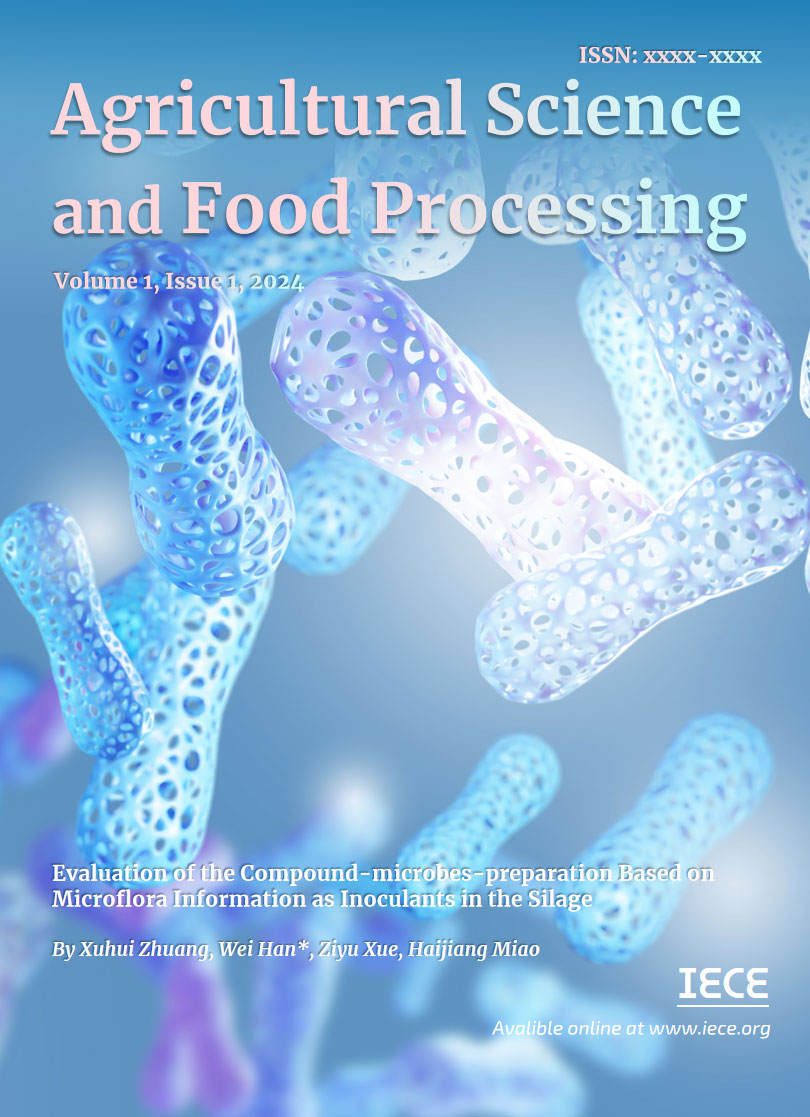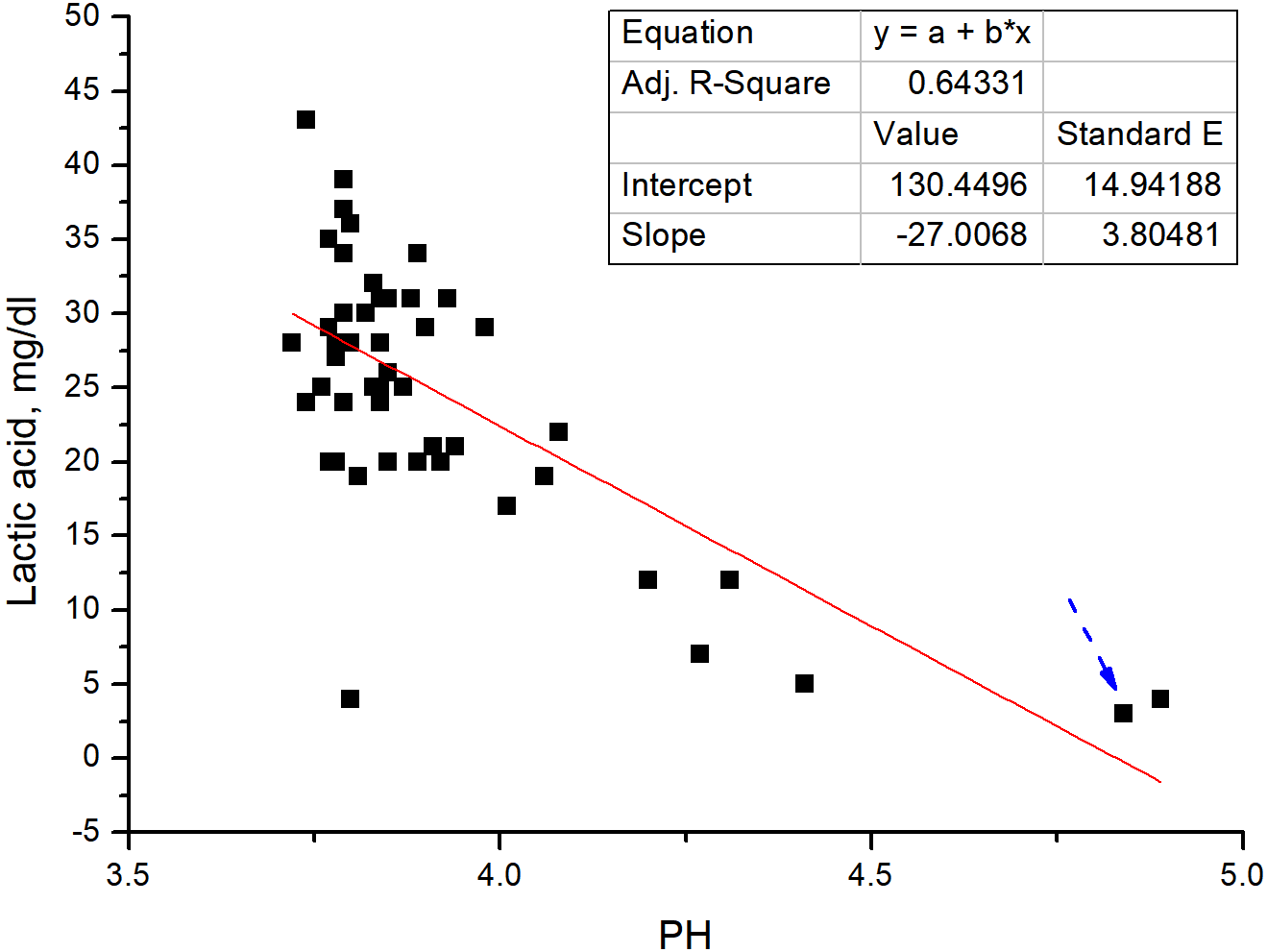Agricultural Science and Food Processing
ISSN: 3066-1579 (Online) | ISSN: 3066-1560 (Print)
Email: [email protected]


 Submit Manuscript
Edit a Special Issue
Submit Manuscript
Edit a Special Issue

[1] Kim, J. G., Yu, Y. S., Wang, L. L., & Li, Y. F. (2022). Evaluation of growth characteristics and forage yield of domestically bred silage corn varieties.
[2] Liu, Q. H., Shao, T., & Bai, Y. F. (2016). The effect of fibrolytic enzyme, Lactobacillus plantarum and two food antioxidants on the fermentation quality, alpha-tocopherol and beta-carotene of high moisture napier grass silage ensiled at different temperatures. Animal Feed Science and Technology, 221, 1-11.
[3] Shinners, K. J., Wepner, A. D., Muck, R. E., & Weimer, P. J. (2009). Aerobic and anaerobic storage of single-pass, chopped corn stover. In 2009 Reno, Nevada, June 21-June 24, 2009 (p. 1). American Society of Agricultural and Biological Engineers.
[4] Dai, T., Dong, D., Wang, J., Yin, X., Zong, C., Jia, Y., & Shao, T. (2023). Effects of wet brewers grains on fermentation quality and in vitro ruminal digestibility of mixed silage prepared with corn stalk, sweet potato peel and dried apple pomace in southeast China. Journal of Animal Physiology and Animal Nutrition, 107(2), 340-349.
[5] Haag, N. L., Nägele, H. J., Reiss, K., Biertümpfel, A., & Oechsner, H. (2015). Methane formation potential of cup plant (Silphium perfoliatum). Biomass and bioenergy, 75, 126-133.
[6] Cui, Y., Liu, H., Gao, Z., Xu, J., Liu, B., Guo, M., ... & Shi, Y. (2022). Whole-plant corn silage improves rumen fermentation and growth performance of beef cattle by altering rumen microbiota. Applied Microbiology and Biotechnology, 106(11), 4187-4198.
[7] Grabner F, M., Grabner H, M., Schein, H., Weidenholzer, E., Busche, T., Rückert-Reed, C., & Buchebner-Jance, M. (2023). Lacticaseibacillus huelsenbergensis sp. nov., isolated from grass silage and corn silage. International Journal of Systematic and Evolutionary Microbiology, 73(10), 006049.
[8] Gismervik, K., Randby, Å. T., Rørvik, L. M., Bruheim, T., Andersen, A., Hernandez, M., & Skaar, I. (2015). Effect of invasive slug populations (Arion vulgaris) on grass silage. II: Microbiological quality and feed safety. Animal Feed Science and Technology, 199, 20-28.
[9] Woolford, M. K. (1990). The detrimental effects of air on silage.
[10] Holzer, M., Mayrhuber, E., Danner, H., & Braun, R. (2003). The role of Lactobacillus buchneri in forage preservation. TRENDS in Biotechnology, 21(6), 282-287.
[11] Marciňáková, M., Lauková, A., Simonová, M., Strompfová, V., Koréneková, B., & Naď, P. (2008). A new probiotic and bacteriocin-producing strain of Enterococcus faecium EF9296 and its use in grass ensiling. Czech Journal of Animal Science, 53(8), 336-345.
[12] Mantovani, H. C., & Russell, J. B. (2003). Inhibition of Listeria monocytogenes by bovicin HC5, a bacteriocin produced by Streptococcus bovis HC5. International journal of food microbiology, 89(1), 77-83.
[13] Flythe, M. D., & Russell, J. B. (2004). The effect of pH and a bacteriocin (bovicin HC5) on Clostridium sporogenes MD1, a bacterium that has the ability to degrade amino acids in ensiled plant materials. FEMS microbiology ecology, 47(2), 215-222.
[14] Amado, I. R., Fuciños, C., Fajardo, P., Guerra, N. P., & Pastrana, L. (2012). Evaluation of two bacteriocin-producing probiotic lactic acid bacteria as inoculants for controlling Listeria monocytogenes in grass and maize silages. Animal Feed Science and Technology, 175(3-4), 137-149.
[15] Mosher, J. J., Bernberg, E. L., Shevchenko, O., Kan, J., & Kaplan, L. A. (2013). Efficacy of a 3rd generation high-throughput sequencing platform for analyses of 16S rRNA genes from environmental samples. Journal of Microbiological Methods, 95(2), 175-181.
[16] Han, W., Zhang, X. L., Wang, D. W., Li, L. Y., Liu, G. L., Li, A. K., & Zhao, Y. X. (2013). Effects of microencapsulated Enterococcus fecalis CG1. 0007 on growth performance, antioxidation activity, and intestinal microbiota in broiler chickens. Journal of Animal Science, 91(9), 4374-4382.
[17] Fouts, D. E., Szpakowski, S., Purushe, J., Torralba, M., Waterman, R. C., MacNeil, M. D., ... & Nelson, K. E. (2012). Next generation sequencing to define prokaryotic and fungal diversity in the bovine rumen. PloS one, 7(11), e48289.
[18] Amato, K. R., Yeoman, C. J., Kent, A., Righini, N., Carbonero, F., Estrada, A., ... & Leigh, S. R. (2013). Habitat degradation impacts black howler monkey (Alouatta pigra) gastrointestinal microbiomes. The ISME journal, 7(7), 1344-1353.
[19] Jami, E., Israel, A., Kotser, A., & Mizrahi, I. (2013). Exploring the bovine rumen bacterial community from birth to adulthood. The ISME journal, 7(6), 1069-1079.
[20] Srinivasan, S., Hoffman, N. G., Morgan, M. T., Matsen, F. A., Fiedler, T. L., Hall, R. W., ... & Fredricks, D. N. (2012). Bacterial communities in women with bacterial vaginosis: high resolution phylogenetic analyses reveal relationships of microbiota to clinical criteria. PloS one, 7(6), e37818.
[21] Bates, S. T., Clemente, J. C., Flores, G. E., Walters, W. A., Parfrey, L. W., Knight, R., & Fierer, N. (2013). Global biogeography of highly diverse protistan communities in soil. The ISME journal, 7(3), 652-659.
[22] Oberauner, L., Zachow, C., Lackner, S., Högenauer, C., Smolle, K. H., & Berg, G. (2013). The ignored diversity: complex bacterial communities in intensive care units revealed by 16S pyrosequencing. Scientific reports, 3(1), 1413.
[23] Han LiYing, H. L., & Zhou He, Z. H. (2013). Effects of ensiling processes and antioxidants on fatty acid concentrations and compositions in corn silages.
[24] Quast, C., Pruesse, E., Yilmaz, P., Gerken, J., Schweer, T., Yarza, P., ... & Glöckner, F. O. (2012). The SILVA ribosomal RNA gene database project: improved data processing and web-based tools. Nucleic acids research, 41(D1), D590-D596.
[25] Cole, J. R., Wang, Q., Cardenas, E., Fish, J., Chai, B., Farris, R. J., ... & Tiedje, J. M. (2009). The Ribosomal Database Project: improved alignments and new tools for rRNA analysis. Nucleic acids research, 37(suppl_1), D141-D145.
[26] DeSantis, T. Z., Hugenholtz, P., Larsen, N., Rojas, M., Brodie, E. L., Keller, K., ... & Andersen, G. L. (2006). Greengenes, a chimera-checked 16S rRNA gene database and workbench compatible with ARB. Applied and environmental microbiology, 72(7), 5069-5072.
[27] Kõljalg, U., Nilsson, R. H., Abarenkov, K., Tedersoo, L., Taylor, A. F., Bahram, M., ... & Larsson, K. H. (2013). Towards a unified paradigm for sequence-based identification of fungi.
[28] Fish, J. A., Chai, B., Wang, Q., Sun, Y., Brown, C. T., Tiedje, J. M., & Cole, J. R. (2013). FunGene: the functional gene pipeline and repository. Frontiers in microbiology, 4, 291.
[29] Wang, Q., Garrity, G. M., Tiedje, J. M., & Cole, J. R. (2007). Naive Bayesian classifier for rapid assignment of rRNA sequences into the new bacterial taxonomy. Applied and environmental microbiology, 73(16), 5261-5267.
[30] Merry, R. J., Dhanoa, M. S., & Theodorou, M. K. (1995). Use of freshly cultured lactic acid bacteria as silage inoculants. Grass and Forage Science, 50(2), 112-123.
[31] Cai, Y., Benno, Y., Ogawa, M., & Kumai, S. (1999). Effect of applying lactic acid bacteria isolated from forage crops on fermentation characteristics and aerobic deterioration of silage. Journal of dairy science, 82(3), 520-526.
[32] Ennahar, S., Cai, Y., & Fujita, Y. (2003). Phylogenetic diversity of lactic acid bacteria associated with paddy rice silage as determined by 16S ribosomal DNA analysis. Applied and Environmental Microbiology, 69(1), 444-451.
[33] Giraffa, G., Chanishvili, N., & Widyastuti, Y. (2010). Importance of lactobacilli in food and feed biotechnology. Research in microbiology, 161(6), 480-487.
[34] Tanizawa, Y., Tohno, M., Kaminuma, E., Nakamura, Y., & Arita, M. (2015). Complete genome sequence and analysis of Lactobacillus hokkaidonensis LOOC260 T, a psychrotrophic lactic acid bacterium isolated from silage. BMC genomics, 16, 1-11.
[35] Wu, J. J., Du, R. P., Gao, M., Sui, Y. Q., Xiu, L., & Wang, X. (2014). Naturally occurring lactic acid bacteria isolated from tomato pomace silage. Asian-Australasian Journal of Animal Sciences, 27(5), 648.
[36] Driehuis, F. (2013). Silage and the safety and quality of dairy foods: a review. Agricultural and food science, 22(1), 16-34.
Agricultural Science and Food Processing
ISSN: 3066-1579 (Online) | ISSN: 3066-1560 (Print)
Email: [email protected]

Portico
All published articles are preserved here permanently:
https://www.portico.org/publishers/iece/